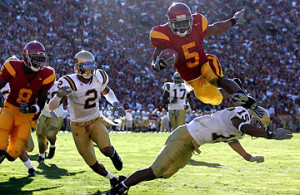The 2000 NFL Draft was the most wide receiver-heavy draft in NFL history. Peter Warrick, Plaxico Burress, and Travis Taylor went in the top 10 picks, Sylvester Morris and R. Jay Soward also went in the first round, and another eleven (11!) wide receivers went in the first 100 picks after that: Dennis Northcutt, Todd Pinkston, Jerry Porter, Ron Dugans, Dez White, Chris Cole, Ron Dixon, Laveranues Coles, JaJuan Dawson, Darrell Jackson, and Gari Scott.
In case you can’t tell by those names, the draft was a complete dud. Expected to revolutionize the NFL with a new wave of athletic wide receivers, the entire class combined to make just 1 Pro Bowl at wide receiver — Coles in 2003 (Dante Hall, drafted in the fifth round, would make two Pro Bowls as a returner). Coles, Burress, and Jackson were all good players, but they were also the only three to eclipse even 5,000 receiving yards.
Twenty years later, we are looking at the next “greatest wide receiver class” of a generation. Oklahoma’s CeeDee Lamb and Alabama’s Jerry Jeudy will be early first round picks; they are expected to be joined in the first round by Jeudy’s teammate, Henry Ruggs III, Clemson’s Tee Higgins, and possibly LSU’s Justin Jefferson, Arizona State’s Brandon Aiyuk, or Colorado’s Denzel Mims.
I looked at the CBS 7-round mock draft and calculated the Draft Value used on wide receivers. Why CBS? Because they were the first website I found that put together a clean table of all draft picks for all 7 rounds, making it easy to calculate draft value. Draft value is simply calculated as the value assigned to each pick, according to my draft value chart, that is used on a wide receiver.
Based on the CBS projections — which has WRs going at 12, 14, 15, 21, 30, 34, 37, 42, 50, 51, and 58 — this would be an outstanding draft class for wide receivers. And while none would be selected in the top 10, there would be a total of 201.6 points of draft capital spent on wide receivers. That would make this one of the top 10 drafts for wide receivers since the common draft era beginning in 1967.
The graph below shows the draft capital used on the position in each draft since 1967. [continue reading…]



